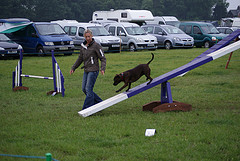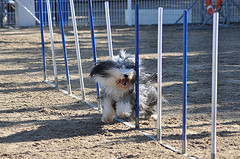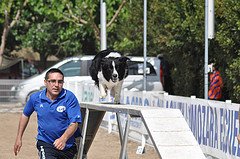|
Dog Agility Training
Dogs of any age can begin Dog Agility Training. Although extra care must be taken with dogs under 12 months old, so that no damage occurs to under developed joints. When starting training with any dog it is best to begin with dog agility equipment that has been lowered from the standard competition heights, use ladders and wobbling boards to allow your dog to gain confidence and a steady footing before progressing to higher levels, all training should take place at a slow pace as the dog may injure themselves .
A dogs response to the challenges of an agility obstacle may vary between dogs, some will take to the idea like a duck to water, while the more timid dog will need more encouragement and may take several weeks before positive progress is made. Once your dog has overcome any fears of the obstacles they will be very willing to perform the tasks presented to them. Try to put yourself in the dogs paws, and see things from a dogs eye view and you may understand why they are hesitant to step onto a teeter-totter board, If you have ever walked across a rope bridge remember how you felt when taking your first step, the ground moving beneath your feet, throwing you off balance, the drop below you, legs feeling like jelly, heart rate going through the roof and remember you had a hand rail to hold onto. If you could step off safely, or better still just not step on in the first place you would, it's called self preservation, dogs are no different. The most difficulties arise with dog agility training when you introduce your dog to the teeter-totter otherwise known as the see-saw and the weaver poles. These being the more challenging of the obstacles they will encounter. Many dogs will not like the see-saw at first as they will not feel secure as the balance pivots, this is understandable and with patience and reassurance you dog will soon master this and gain confidence.
Many experienced handlers prefer to train their dogs at home instead of at a training club who often have classes targeted at beginners. The advantages of joining a
dog agility
class are: Whichever method of dog agility training you choose enjoy it! from dog agility training to free pet advice Agility dog jumping
|
Other Topics
Dog Agility Equipment
Dog Agility Course Plans
Agility Dog Jumping
working dogs
Dog Breeds

Jump hoop and more agility equipment







